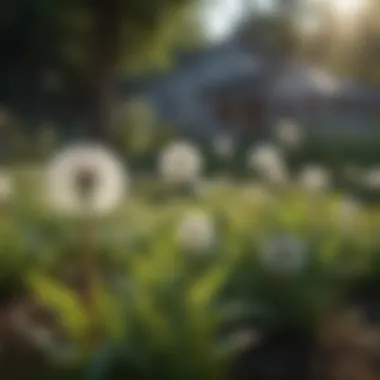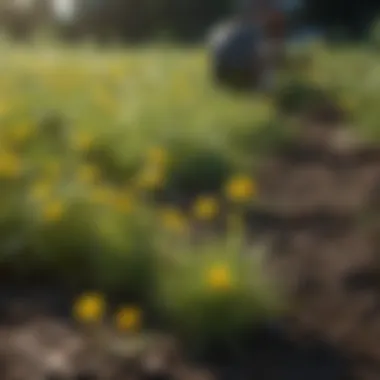Effective Strategies for Dandelion Management


Intro
Managing dandelions can be a tricky endeavor, especially for those looking to maintain a pristine lawn or an organic garden. Known scientifically as Taraxacum officinale, these resilient plants are often viewed as pesky interlopers. Their vibrant yellow flowers might liven up a landscape, but they can also compete strongly with cultivated plants, drawing nutrients and water away. To tackle dandelions effectively, it's crucial to understand a few foundational concepts, the context of their presence, and the tools available today.
Key Concepts and Terminology
Basic Definitions
Before diving into the thick of it, it's essential to grasp some key terms related to dandelion management. Here are a couple of significant concepts:
- Chemical Treatments: Products designed to control or eliminate unwanted plants, including herbicides specifically targeted at dandelions.
- Selective Herbicides: These are formulations that target specific kinds of plants like dandelions, minimizing harm to grasses and other desirable species.
Historical Context
The dandelion’s journey from native weed to widespread adversary speaks volumes about human cultivation practices. Initially revered for its medicinal properties, the dandelion has evolved into a symbol of lawn neglect. The historical context encourages us to reflect on how agricultural advancements have inadvertently allowed these hardy weeds to thrive. Changing farming methods, particularly those that focus heavily on monoculture, have set the stage for dandelion proliferation.
Recent Innovations and Trends
Technological Advancements
As time goes on, there are promising developments in chemical treatments designed for dandelions. These days, several new herbicides make use of advanced formulations that enhance efficacy while reducing environmental risks. For instance, products that utilize aminopyralid are gaining traction due to their potent action on broadleaf weeds, including dandelions, while posing a lesser risk to surrounding flora.
Sustainable Practices
A noticeable trend is the shift towards sustainable gardening. Many growers are searching for ways that not only manage dandelions but do so while considering the environmental impact. Techniques such as integrated weed management encourage combining chemical and non-chemical strategies, like manual weeding and mulching, to keep dandelions at bay without harming pollinators and other beneficial insects.
Practical Applications and Techniques
Step-by-step Guides
- Identification: Recognize whether the dandelions are invasive in your particular setting. Assess if there’s a need to act.
- Select Your Herbicide: Opt for a selective herbicide to minimize harm to your desired plants.
- Timing: Apply the treatment during the flowering phase of the dandelion, as it’s the most effective time.
- Follow Instructions: Observe the recommended guidelines for application to ensure maximum effectiveness.
Case Studies
Example of a Lawn Treatment: In a suburban area where homeowners struggled with dandelion invasion, a local council introduced a community program that promoted proper herbicide application techniques. They provided educational workshops that explained the right time to treat lawns—post-flowering in the spring. The results were promising: many residents noted a significant decrease in dandelion counts by the following season.
"A well-maintained lawn is about balance; managing dandelions is less about eradication and more about control."
By equipping ourselves with the right knowledge and the latest innovations, managing dandelions can transition from a burdensome chore to a manageable task, allowing for healthy, thriving gardens and fields.
Prolusion to Dandelions
Dandelions, often seen as mere nuisances in the landscape of our gardens and lawns, possess a unique charm and resilience that merits closer examination. These vibrant yellow flowers have made a name for themselves, adapting to diverse environments and often outpacing traditional floral competitors. Understanding the dandelion's life cycle, growth habits, and ecological roles provides a foundation for effective management strategies. In this sense, learning about dandelions isn't just about controlling unwanted plants; it’s about recognizing their strengths and weaknesses.
The importance of the topic of dandelion management extends beyond mere aesthetics. For farmers and gardeners alike, these hardy plants can disrupt the health of cultivated crops, reduce yields, and lead to increased costs in maintaining a landscape. Their extensive root system can make them particularly difficult to eradicate, often requiring a combined approach to manage effectively. Moreover, the ability of dandelions to reproduce both sexually and vegetatively gives them an advantage that demands strategic intervention.
Beyond control measures, exploring dandelions opens the door to an understanding of soil health and biodiversity. Proper management practices not only address the immediate concerns but also align with broader ecological goals. As we navigate through this article, readers will discover how dandelion control can be effectively integrated with sustainable practices, benefiting both the land and the farmer.
The Biology of Dandelions
Dandelions, scientifically known as Taraxacum officinale, exhibit fascinating biological traits that underline their persistence in various settings. Growing from a deep taproot, these plants can access nutrients and water from deeper soil layers, making them resilient to stressors such as drought. Their leaves, which are typically jagged and serrated, form a rosette at ground level, photosynthesizing efficiently and allowing the plant to thrive even in less than ideal conditions.
Moreover, their blooming period spans from early spring to late fall, ensuring that they can flower when few other plants do. This ability to disperse seeds through a unique mechanism known as anemochory—where seeds are carried by the wind—has led to their widespread proliferation. Each mature dandelion can produce up to 15,000 seeds, which are tiny and easily transported to new locations.
Reasons for Dandelion Control
Controlling dandelions is not simply about achieving a manicured lawn or pristine garden; it is about maintaining balance in an ecosystem that can be disrupted by their presence. Here are some key reasons why managing dandelions is crucial:
- Agricultural Impact: In farming settings, dandelions compete with crops for nutrients, water, and light, which can lead to reduced agricultural productivity. Their fast growth can quickly outcompete less vigorous crops.
- Pest Control: While dandelions can attract beneficial insects, they can also host pests. Managing these plants may help prevent pest populations from becoming unmanageable.
- Soil Management: Overcrowding by dandelion roots can disrupt soil structure, complicating the growth of desired plants. This can lead to compaction and hinder drainage.
- Aesthetic Concerns: For homeowners, a lawn filled with dandelions can be unpleasing to the eye, prompting a need for control measures to maintain property value.
In essence, understanding the biology of dandelions and recognizing the reasons for their control creates a compelling case for carefully tailored management strategies.
Chemical Options for Dandelion Control


Controlling dandelions effectively is paramount for maintaining aesthetically pleasing lawns and gardens, as well as for ensuring healthy agricultural lands. Unauthorized growth of these resilient weeds can lead to decreased crop yields and hinder the growth of desired plants. Chemical options for dandelion management, particularly herbicides, play a crucial role in addressing these challenges. It’s vital to understand these chemical solutions, their modes of action, and the implications of their use in a sustainable manner.
The selection of chemical treatments can vary based on the context—whether it's a residential lawn, a public park, or a commercial agricultural field. Proper usage of these products allows growers and homeowners alike to manage dandelion populations effectively while minimizing harm to surrounding flora and fauna. When choosing herbicides, factors such as target weed life cycle, application timing, and environmental impact must be considered.
Herbicides: An Overview
Herbicides are chemical substances that are designed specifically to kill or inhibit the growth of unwanted plants. They operate through different mechanisms, and understanding these can significantly influence their effectiveness against dandelions.
Most herbicides can be classified into two main categories: selective and non-selective. Selective herbicides target specific weeds while leaving surrounding plants unharmed. This feature is especially useful in maintaining healthy grass or crop areas. On the other hand, non-selective herbicides kill all plants they come in contact with, making them suitable for clearing large areas where vegetation isn't desired.
"Choosing the right type of herbicide can mean the difference between a thriving lawn and a weedy mess.”
Key Points on Herbicides:
- Mode of action: Herbicides can affect plants in various ways, such as disrupting photosynthesis, inhibiting cell division, or blocking root development.
- Persistence in the soil: Some herbicides remain in the soil for longer periods and could impact future crop or plant growth.
- Effectiveness under varying conditions: Different herbicides may work better under certain environmental conditions, including soil type and moisture level.
Selective vs. Non-selective Herbicides
Understanding the difference between selective and non-selective herbicides is essential when managing dandelions. Selective herbicides are formulated to target specific types of weeds, which allows gardeners to protect desirable plants within their growing areas. For instance, 2,4-D is a selective herbicide that effectively targets broadleaf weeds like dandelions without harming grass.
In contrast, non-selective herbicides such as glyphosate don't discriminate between wheat and weeds. They kill any green plant material they contact. While this trait can be very powerful for scenarios requiring complete vegetation removal, it's essential to use them with caution to avoid unintended damage to wanted plants.
Distinctions in Application:
- Selective Herbicides:
- Non-selective Herbicides:
- Best used in lawns and gardens.
- Less risk of collateral damage to desirable plants.
- Often require multiple applications for persistence.
- Useful for large clearances or areas where replanting isn't immediate.
- Fast-acting but can be harmful to surrounding vegetation.
- Often have restrictions on replanting after application.
Common Chemicals for Dandelions
When it comes to tackling the robust and relentless spread of dandelions, understanding the array of chemicals available is crucial for effective management. Dandelions thrive in a variety of conditions, making it vital for agriculture farmers and gardening enthusiasts to have a targeted approach. Common chemicals used for controlling dandelions not only help in reducing their numbers but also contribute to maintaining the overall health of gardens, lawns, and agricultural fields. This section discusses various chemicals, their mechanisms, effectiveness, and important usage considerations that can help anyone looking to manage this persistent weed effectively.
,4-D: Mechanism and Efficacy
2,4-D is one of the most recognized herbicides in the battle against dandelions. This chemical is a synthetic auxin that acts as a growth hormone, affecting the plant’s growth processes. Once applied, 2,4-D is absorbed through the leaves and roots, disrupting normal growth, leading to uncontrollable cell elongation. This overstimulation ultimately causes the plant to collapse.
- Efficacy: 2,4-D targets broadleaf weeds, including dandelions, while sparing grasses. Farmers appreciate its effectiveness when dealing with large infestations without damaging desirable plants.
- Application Timing: Optimal results are achieved when applied during the rosette stage of dandelion growth, typically in the spring or early fall. Spraying during these periods ensures the herbicide is most effective when the plant is actively growing.
However, several considerations are necessary. Users must be vigilant about the concentration used and the proximity of desirable plants since it can cause harm if dripped during application. Proper measurements and careful aiming are key to using 2,4-D effectively.
Glyphosate: Effectiveness and Usage
Glyphosate is another widely utilized herbicide in the agricultural sector. Its systemic nature can be advantageous for eliminating deep-rooted perennial plants and annual species alike. It blocks a specific enzyme pathway crucial for plant growth, which leads to eventual plant death.
- Effectiveness: Glyphosate is non-selective, meaning it will kill any plant it comes into contact with. Thus, it's vital to apply it only to areas where dandelions are present and preferably when they are actively growing to ensure maximum absorption.
- Ineffective in the Wrong Timing: If applied during dormancy, its effectiveness diminishes significantly. Farmers often employ Glyphosate following a targeted mowing or when the dandelions are budding to ensure it reaches the leaf tissue efficiently.
The potential for glyphosate to affect non-target species raises concerns among users. Careful consideration of wind drift and rain impact is essential when planning applications.
Triclopyr and Its Applications
Triclopyr is typically less known but has its own merits, particularly in forest and non-crop settings for controlling woody plants and perennial broadleaf weeds, including dandelions. While it's mainly noted for controlling brush, it becomes a tool for managing tough dandelion populations.
- Modes of Action: It operates similarly to 2,4-D as a growth regulator but has a distinct mechanism targeting specific plant enzymes, leading to effects like stunted growth and death in treated areas. This makes it a versatile option for maintaining non-crop areas.
- Application Specifically: Often, triclopyr can be mixed with other herbicides to create a more comprehensive solution for controlling difficult species. Application should be tailored based on the site specifics, and caution should be taken with nearby vegetation to prevent unintentional damage.
It's clear that having a solid understanding of these chemicals allows for targeted approaches to dandelion management, making it easier to sustain healthy landscapes and productive fields. All herbicides come with responsibilities and risks, so understanding their properties, effective applications, and potential side effects is essential.
Application Methods
The application methods used in dandelion management are critical for achieving effective outcomes. Choosing the right application strategy not only enhances herbicide efficacy but also mitigates potential negative impacts on the surrounding environment. Understanding the nuances of various application methods can empower farmers and gardening enthusiasts to tailor their approaches, ensuring optimal control of these resilient weeds. The following elements highlight the importance of proper application techniques:
- Increase in Efficiency: When applied correctly, herbicides can penetrate the plant structure thoroughly, leading to quicker and more effective weed reduction.
- Minimized Resistance Development: A strategic approach to herbicide application helps manage the risk of dandelions developing resistance to chemicals. Alternating different application methods can disrupt the growth cycle of these plants.
- Enhanced Safety: By adhering to recommended safety protocols during application, farmers can safeguard themselves, their families, and the surrounding wildlife from the potential hazards of chemical exposure.


Timing of Applications
Timing is a crucial factor in dandelion management. Applying herbicides at the right stage of plant development can make a world of difference. Research indicates that dandelions are most vulnerable during their early growth phase, typically in the spring when they first germinate or when they are actively blooming. Here are some considerations:
- Early Application: Targeting young dandelions during their rosette stage increases the likelihood of successful control, as this is when they are still small and less resilient.
- Avoiding Stress Weather: Avoid application during droughts or overly wet conditions. Weeds under stress are less likely to absorb herbicides effectively.
- Seasonal Variations: Keep an eye on the seasonal growth patterns in your area; applying during late spring and before summer usually yields better results.
Spray Techniques for Effective Coverage
Effective spraying techniques play a vital role in ensuring that the herbicide reaches and treats the dandelions properly. Using optimal spray strategies can minimize waste and enhance application precision. Here are some key strategies to consider:
- Uniform Coverage: Make sure to spray evenly, covering both the top and the underside of the leaves. Dandelions can be tricky, so ensure a thorough application.
- Recommended Nozzle Types: Using the appropriate spray nozzle is essential for achieving the right droplet size. Fine droplets may drift away, while larger droplets might not stick well.
- Wind Considerations: Wind can be a significant factor. Aim to apply herbicides on calm days to prevent undesirable drift to non-target plants. Ideally, keeping wind speeds below 5 mph is recommended.
Using Granular Herbicides
Granular herbicides offer a different avenue for controlling dandelions. These types of herbicides can be beneficial in various scenarios, especially for widespread infestations. Here’s what you should know about utilizing granular forms:
- Application Techniques: Granular herbicides should be spread evenly over the infested area. Using a spreader can aid in achieving a consistent application, thus ensuring all targeted areas receive treatment.
- Water Activation: Most granular herbicides require activation by rain or irrigation to break down properly and penetrate the soil effectively. Therefore, timing your application with upcoming weather events is paramount.
- Reduced Risk of Drift: Compared to liquid herbicides, granular forms are less prone to drift, making them a safer choice during breezy conditions.
Remember, effective dandelion management doesn't rely solely on chemicals. Combining chemical treatments with cultural practices like proper mowing, maintaining turf health, and understanding local weed dynamics will yield the best long-term results.
By honing in on timing, employing effective spray techniques, and judiciously using granular herbicides, you can dramatically improve your approach to managing dandelions. The synergy between these methods ensures a comprehensive and effective strategy, ultimately leading to healthier landscapes.
Safety Considerations
When dealing with dandelions, especially through chemical control methods, safety is a key concern. Understanding and implementing proper safety measures is not only essential for an effective control strategy but also for protecting human health and the environment. As dandelions can spring up in various places, from home gardens to municipal parks, anyone involved in their control must be cognizant of the potential risks and repercussions that come with chemical applications.
Protective Measures for Application
Taking precautions during application can significantly mitigate health and environmental risks. Here are some fundamental protective measures to adopt:
- Personal Protective Equipment (PPE): Always wear protective gear including gloves, goggles, and masks. This will help shield your skin and respiratory system from harmful chemicals.
- Read Product Labels: Every chemical herbicide comes with an instruction manual or label that outlines how to use it safely. Adhering to these guidelines can save from accidental exposure.
- Weather Conditions: Applying chemicals during calm weather conditions, avoiding windy days can prevent drift. Wind can carry herbicides to unintended areas, affecting other plants, beneficial insects, or even human occupants nearby.
- Application Timing: Stick to the recommended timings for application as specified on product labels. Many herbicides work best under specific temperature and humidity conditions, which can minimize risks and boost effectiveness.
"A stitch in time saves nine." Addressing safety before acting can prevent much bigger problems down the road.
Impact on Non-target Species
It's crucial to recognize that chemical treatments do not discriminate; they can affect a wide array of organisms, not just the pests they are aimed at. This collateral damage can have serious implications for ecosystems. Here are aspects to consider:
- Biodiversity Loss: Herbicides can impact native plant species, inadvertently leading to a loss of biodiversity in a given area. It’s important to choose selective herbicides when possible, those that target specific unwanted species while sparing others.
- Effects on Pollinators: Bees and other pollinators, vital for numerous ecosystems and agriculture, can be harmed if they come into contact with chemicals or consume contaminated pollen from treated plants. Always consider the timing of applications in relation to pollinator activity.
- Soil Organism Health: Chemicals can also disrupt the delicate balance of soil microbiomes which play critical roles in nutrient cycling and plant health. This means that while trying to control dandelions, beneficial organisms in the soil might suffer as well.
- Water Bodies Impact: Be cautious of runoff entering lakes and streams. Herbicides can contaminate water sources, harming aquatic life. It's best to apply chemicals away from water bodies, especially during rains or when the ground is saturated.
In summary, managing dandelions effectively requires a balance between chemical controls and safety considerations that protect both human health and the natural environment. Armed with the right knowledge and practices, one can navigate the challenges posed by these resilient pests.
Environmental Implications
Understanding the environmental implications when dealing with dandelions is critical for farmers and gardening enthusiasts alike. This section sheds light on key aspects that can significantly influence not just the immediate area but the broader ecosystem as well. Controls put into place to manage dandelions often reach far beyond their intended targets. Naturally, that raises questions about runoff, soil health, and the delicate balance we tread when employing chemical treatments.
Runoff Concerns
When rain falls or irrigation occurs, runoff can transport chemicals from treated areas to surrounding environments. This is particularly concerning in agricultural fields where excess herbicide can seep into nearby waterways. Such contamination can harm aquatic life and disrupt local ecosystems.
To mitigate runoff concerns, consider the following practices:
- Buffer Zones: Establishing non-treated buffer zones around sensitive areas like ponds or rivers can help absorb excess water and filtration.
- Rainy Day Restrictions: Avoid applying chemical treatments right before rain to minimize the risk of runoff.
- Soil Integrity: Enhancing soil structure by utilizing organic matter can improve water retention and lessen the likelihood of runoff carrying chemicals away.
These practices provide farmers and gardeners a way to prevent chemical escape and protect surrounding habitats while still managing dandelion infestations effectively.
Soil Health Post-treatment
The health of soil after dandelion treatments is another factor that demands attention. Chemicals can both negatively and positively affect soil ecosystem functioning. Herbicides can break down soil microbial communities, which are essential for breakdown of organic matter and nutrient cycling. Therefore, understanding how these treatments affect soil health is pivotal.
Here are key points to consider regarding soil health post-treatment:
- Microbial Recovery: After treatment, it’s crucial to provide conditions that encourage microbial populations to bounce back. Adding compost or organic fertilizers can help rejuvenate life in the soil.
- Crop Rotation: Implementing a careful crop rotation plan can aid in restoring soil nutrients while reducing the chances of dandelions returning in high numbers.
- Soil Testing: Regular testing of soil post-application is beneficial. It can give insights into nutrient levels and the overall impact of treatment strategies.


Approaching soil health with a proactive mindset can contribute to a sustainable farming practice while successfully managing dandelions.
"Healthy soil is the foundation of successful agriculture, influencing everything from yield to plant health."
Integrating Chemical Control with Other Practices
When it comes to managing dandelions effectively, merely relying on chemical treatments isn't enough. The idea is to create a holistic approach that brings together the best of chemical control and sustainable management techniques. Understanding how chemical control fits into a broader management strategy can make all the difference in achieving lasting results. This integration helps in reducing resistance buildup, protecting non-target species, and enhancing the overall health of the ecosystem.
Cultural Practices for Dandelion Management
Cultural practices play a vital role in preventing dandelions from thriving in the first place. A few of these methods include:
- Proper Lawn Care: Regular mowing at the right height can hinder dandelion growth. Keeping grass taller shades the soil and makes it harder for dandelion seeds to germinate.
- Soil Health: Conducting soil tests and amending nutrient deficiencies can lead to a stronger lawn. A healthy, dense lawn competes better against invasive weeds like dandelions.
- Watering Techniques: Overwatering can lead to weakened grass roots, making it easier for dandelions to invade. Use deep watering schedules to encourage strong root systems.
- Mulching in Gardens: Applying a layer of mulch around your plants can help suppress weeds, including dandelions.
Each of these practices provides a solid foundation for chemical controls, enabling them to work more effectively when applied.
Combining Chemical and Mechanical Methods
Addressing dandelions can also benefit from combining chemical methods with mechanical approaches. Mechanical removal can be labor-intensive but is often required for optimal success, especially in areas with a heavy infestation. Here are some common methods:
- Hand Pulling: It may seem old-fashioned, but pulling dandelions by hand or using a weeding tool can be remarkably effective. Make sure to remove the entire taproot to prevent regrowth.
- Tilling: For larger areas, tilling can disrupt the dandelions' growth cycle. However, repeated tilling without follow-up controls can result in more weed problems.
- Using Lawn Aerators: Aerating the lawn can improve water penetration and soil conditions for turf, making it easier for grass to thrive while weakening dandelion roots.
Integrating these mechanical tactics with chemical applications means the chemicals are more effective when dandelions are handled in tandem with physical methods. For example, treating a newly disturbed soil after hand-pulling dandelions with an appropriate herbicide can minimize re-infestation.
Effective dandelion management is not just about choosing the right chemical; it's about creating an environment that doesn't allow them to thrive in the first place.
Finding a balance between these various strategies ultimately leads to a more sustainable and effective weed management plan. This multi-faceted approach not only addresses current dandelion problems but also reduces the likelihood of future invasions.
Case Studies and Practical Examples
Understanding and managing dandelions can be a tall order, given their tenacity and ability to proliferate in various environments. This is where case studies and practical examples become crucial. They provide real-world insights that go beyond theories and textbook strategies. An analysis of successful herbicide applications to control dandelions coupled with challenges faced by others trying to do the same serves to inform and guide anyone tackling these vigorous weeds.
Successful Herbicide Applications
To appreciate the nuances of effectively managing dandelions through chemical treatments, looking at specific cases is invaluable. Many farmers and landscapers have reported success using personally tailored approaches. For example, in a residential area with persistent dandelion outbreaks, the application of 2,4-D herbicide during the late spring showed notable results. The timing was critical, aligning with the broadleaf perennial's growth phase, leading many to observe a significant reduction in dandelion presence over the season.
Another compelling case is that of a community garden which adopted glyphosate-based treatments. Their method involved a spot treatment approach rather than blanket spraying, which reduced harm to surrounding plants while effectively targeting the dandelion populations. This careful precision not only sparked a lively discussion among the gardeners but also resulted in improved yields of cultivated plants, demonstrating the interconnectedness of managing weeds and nurturing crops.
"Case studies reveal that it’s not always about the chemicals, but also about the method of application and timing."
Challenges Faced in Dandelion Control
Managing dandelions brings its own set of hurdles, often making the task seem like trying to catch smoke with bare hands. For instance, one agricultural operation noted that while they initially applied herbicides successfully, the subsequent seasons brought even more robust dandelion growth. This phenomenon occurred because the herbicides inadvertently affected selective native flora, weakening the competitive balance that usually keeps dandelions in check.
Moreover, certain herbicide resistance has emerged as a pressing issue. Farmers reported that over-application of glyphosate in particular regions led to the surprising proliferation of hardier dandelion strains. This raised alarm bells across local agricultural circles, prompting a reevaluation of herbicide rotations and the criteria for applications.
The practical takeaway from these challenges lies in the need for continuous learning and adaptation. Case studies highlight that what worked in one season may not yield the same results in another. Thus, a flexible approach combining chemical control with cultural practices, such as crop rotation and vigilant monitoring, is essential to outsmart these pesky weeds.
In summary, case studies and practical examples provide real-life lessons that are invaluable for managing dandelions effectively. They inform strategies, demonstrate challenges, and highlight successful techniques that can be replicated or adapted across various settings.
The End
The examination of managing dandelions provides a layered understanding pivotal for effective control and sustainable growth in agricultural and garden settings. Acknowledging the significance of this weed isn’t just about its annoyance in aesthetic terms; instead, it unveils its role in the ecosystem and complexities surrounding its eradication. The different approaches discussed in this article, such as chemical treatments and their application, hold essential strategies for effectively managing dandelions while minimizing environmental impacts.
Summarizing Effective Strategies
To effectively manage dandelions, it’s essential to integrate a variety of strategies that encompass chemical treatments, cultural practices, and careful monitoring. The following key points encapsulate the best approaches:
- Proper Timing: Applying herbicides at specific life stages of dandelions maximizes efficacy. For instance, targeting the plant during its rosette stage ensures a higher success rate.
- Selectivity in Herbicides: Utilizing selective herbicides like 2,4-D ensures only dandelions are affected, leaving desirable plants unharmed.
- Combination Practices: Merging chemical methods with mechanical controls, such as digging out roots, can enhance results and reduce reliance on chemicals alone.
- Continuous Monitoring: Keeping an eye on dandelion resurgence is vital; a proactive stance will prevent large-scale infestations.
By employing these strategies, landowners can not only manage dandelions more effectively but also promote healthier landscapes.
Future Directions in Dandelion Management
Looking ahead, the management landscape for dandelions and similar weeds is likely to evolve significantly. Here are some potential avenues worth exploring:
- Biological Control Methods: Research into biological controls may provide sustainable alternatives to chemical remedies, catering to an eco-conscious audience.
- Smart Technology Utilization: Advanced tracking and monitoring tools can aid farmers in scheduling treatments and forecasting dandelion growth patterns with precision.
- Education and Outreach: Increasing awareness among farmers about integrated pest management (IPM) practices can lead to more widespread adoption of sustainable methods.
- Emerging Research: Keeping an eye on studies aimed at understanding dandelion genetics might reveal novel weaknesses that can be exploited.
Embracing these future directions is not just essential for successful weed management but crucial for maintaining balance in our ecosystems amidst increasing agricultural pressures.















